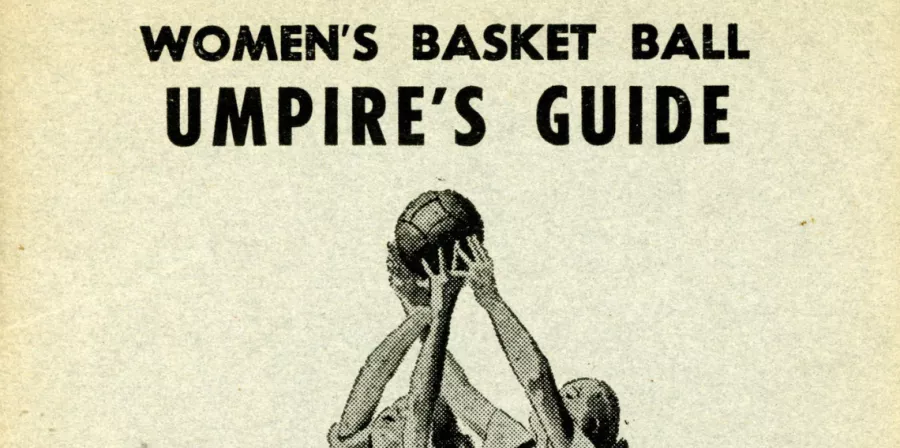A quick peruse of the hardcopy career files of Netball Victoria’s Life Members, Legends and Hall of Fame inductees reveals that past and present members of the umpiring fraternity are well-represented. A few of these notable umpires who officiated during the1960s (and beyond) include:
Ella Athorn, who began her long umpiring career at Timboon in the 1940s, and was still actively involved with the sport as an Executive Member of the Dandenong and District Netball Umpires’ Association in 1999. She was awarded her ‘A’ Grade badge in 1953 and Ella’s service to netball was publicly acknowledged when the pavilion at Greaves Reserve in Dandenong was named in her honour (the pavilion later becoming part of the larger Gloria Pyke Netball and Sport Complex).

Ella Athorn (Courtesy of Netball Victoria)
Anne George, who coached, lectured and tested umpires throughout Gippsland between 1958 and 1966, gaining her ‘A’ Grade Umpires Badge in 1960. Among many other netball achievements spanning 50 years of service, including the award of Life Membership in 1978, Anne was instrumental in collecting historical material for Netball Victoria.

Anne George (Courtesy of Netball Victoria)
Patricia Kuhne, who attained her ‘A’ Grade Umpires Badge in 1969, was appointed as an umpires’ course instructor for the Victorian Netball Association (now Netball Victoria) by 1980. She also achieved Life Membership with the Leongatha and District Netball Association in 1986, and as recognition of her many accomplishments in 1995 she was presented with a unique watch, now part of the Edith Hull Collection. Patricia was also awarded Life Membership of Netball Victoria in 2004.

A unique watch presented to Patricia Kuhne (Courtesy of Netball Victoria).
Some of the many other women involved in umpiring in Victoria during the 1960s included Joyce Brown, Valerie Morrison, Pat Pumpa, M. Melvin-Cross, B. Blackhall, Nonie Oppy, and M. Donahue.
Various related items of memorabilia have also survived the passage of time, with umpiring badges and pins, umpiring guidebooks and a variety of whistles making up part of the Edith Hull Collection.

The family-run, British-based, Acme Company (now owned and managed as a private firm) claim to have invented the world’s first sports whistle in 1884. The Acme ‘Thunderer’, made in England [pictured above right], thus became the default umpire’s whistle when netball was first played in Victoria from the late 1890s. A larger Aussie ‘Thunderer’ [pictured above left] was developed later [Courtesy of Netball Victoria].
However, it is probably the evolution of booklets and guides used by umpires to promulgate and enforce the rules of the game that provide unique insights into how netball was first played. For instance, in the ‘1930 Rules’ of the Victorian Girls’ Basket Ball Association, published by ‘Hartleys Sports Stores’, the instructions for marking the ‘ground’ stipulated that ‘A line shall be drawn from the mid-point of the arc of the shooting circle to the centre of the nearest transverse line’. These rules also mandated that ‘an ordinary sized Association (Soccer) football, ie., between 27 and 28 inches in circumference’, had to be approved by the umpire.
Curiously, the dimensions of what had become known as the ‘court’ in the ‘Rules of Basket Ball’, as published by ‘Hartleys Sports Store’ in 1941, were slightly different.


The ‘ground’ dimensions from a 1930 rule book (on the left), contrasted with larger ‘court’ dimensions as set out in a rule book from 1941 (on the right) [Courtesy of Netball Victoria].
Furthermore, the protocols for commencing a match were strict: ‘The game shall be started by bouncing the ball down in the centre of the field at the beginning of each round, and after each goal. The ball shall be bounced about shoulder high by the umpire who shall stand in the circle, and it shall not be in play until it has been touched by one of the two centres who, at the time the ball is bounced, shall stand outside the centre circle. They must stand facing each other, with their backs to the side lines, and with their feet outside the circle, and hands touching behind [their] back until the ball has been bounced’.
With some other rules, the umpire was permitted to use their discretion, including situations where players were ‘offside’. In this context, the rule book clearly stated that ‘The decisions of the umpire shall be final and without appeal. Only Captains of teams shall have the right to bring points of umpiring before the umpire, and these are to be brought up during the intervals only’. Importantly, for ‘rough play’ the umpire had a discretionary power ‘… to warn the offending player or to suspend her from further participation in the game’.
By the 1960s, the publication of the ‘Women’s Basket Ball Umpire’s Guide’ was published under the imprimatur of the All Australia Women’s Basket Ball Association (AAWBBA). The size and format of this item reflected the fact that almost half the booklet was taken up with Section 9, which provided detailed information concerning AAWBBA ‘Umpires’ Examinations’, consisting of a ‘Theoretical Exam’ and a ‘State Exam’.


The 1961 AAWBBA rule book (left) consisted of 18 pages. By 1966 the booklet (right) had been expanded to 38 pages [Courtesy of Netball Victoria].


Those Victorian applicants who passed their umpire examinations received certificates and much-cherished badges, the designs of which have varied over the years [Courtesy of Netball Victoria].

A very rare and delicate AAWBBA umpire’s badge from 1938, donated by Marjorie Beaumont, an inaugural member of the VWBBA Umpires’ Association, formed in the 1930s, is also part of the Edith Hull Collection [Courtesy of Netball Victoria].
